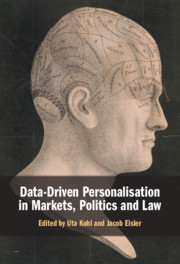Book contents
- Data-Driven Personalisation in Markets, Politics and Law
- Data-Driven Personalisation in Markets, Politics and Law
- Copyright page
- Contents
- Figures
- Tables
- Contributors
- Preface
- Part I Introduction: Theoretical Perspectives
- Part II Themes: Personal Autonomy, Market Choices and the Presumption of Innocence
- Part III Applications: From Personalised Medicine and Pricing to Political Micro-Targeting
- 9 ‘P4 Medicine’ and the Purview of Health Law: The Patient or the Public?
- 10 Personalised Pricing: The Demise of the Fixed Price?
- 11 Data-Driven Algorithms in Criminal Justice: Predictions as Self-fulfilling Prophecies
- 12 From Global Village to Smart City: Reputation, Recognition, Personalisation, and Ubiquity
- 13 Micro-targeting in Political Campaigns: Political Promise and Democratic Risk
- Part IV The Future of Personalisation: Algorithmic Foretelling and Its Limits
- Index
10 - Personalised Pricing: The Demise of the Fixed Price?
from Part III - Applications: From Personalised Medicine and Pricing to Political Micro-Targeting
Published online by Cambridge University Press: 09 July 2021
- Data-Driven Personalisation in Markets, Politics and Law
- Data-Driven Personalisation in Markets, Politics and Law
- Copyright page
- Contents
- Figures
- Tables
- Contributors
- Preface
- Part I Introduction: Theoretical Perspectives
- Part II Themes: Personal Autonomy, Market Choices and the Presumption of Innocence
- Part III Applications: From Personalised Medicine and Pricing to Political Micro-Targeting
- 9 ‘P4 Medicine’ and the Purview of Health Law: The Patient or the Public?
- 10 Personalised Pricing: The Demise of the Fixed Price?
- 11 Data-Driven Algorithms in Criminal Justice: Predictions as Self-fulfilling Prophecies
- 12 From Global Village to Smart City: Reputation, Recognition, Personalisation, and Ubiquity
- 13 Micro-targeting in Political Campaigns: Political Promise and Democratic Risk
- Part IV The Future of Personalisation: Algorithmic Foretelling and Its Limits
- Index
Summary
An online seller or platform is technically able to offer every consumer a different price for the same product, based on information it has about the customers. Such online price discrimination exacerbates concerns regarding the fairness and morality of price discrimination, and the possible need for regulation. In this chapter, we discuss the underlying basis of price discrimination in economic theory, and its popular perception. Our surveys show that consumers are critical and suspicious of online price discrimination. A majority consider it unacceptable and unfair, and are in favour of a ban. When stores apply online price discrimination, most consumers think they should be informed about it. We argue that the General Data Protection Regulation (GDPR) applies to the most controversial forms of online price discrimination, and not only requires companies to disclose their use of price discrimination, but also requires companies to ask customers for their prior consent. Industry practice, however, does not show any adoption of these two principles.
Keywords
- Type
- Chapter
- Information
- Data-Driven Personalisation in Markets, Politics and Law , pp. 174 - 189Publisher: Cambridge University PressPrint publication year: 2021
- 1
- Cited by



